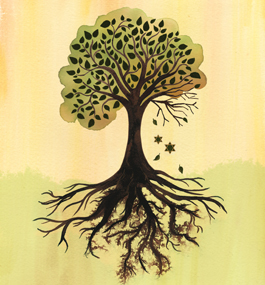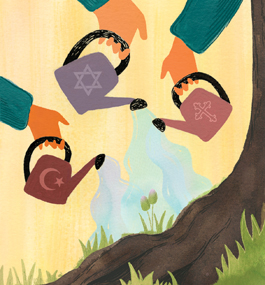Healing Roots
The Tree of Life synagogue massacre united many communities of faith in defying hate and violence even as it strengthened Jewish identity.

Alyssa Carvara
by Joseph Dorman
The tragic October 2018 massacre at Tree of Life/Or L’Simcha synagogue, in Pittsburgh’s Squirrel Hill neighborhood, was the worst incident of antisemitic violence in U.S. history.
A year earlier, in 2017, the Anti-Defamation League reported a 60% surge in antisemitic incidents in the U.S., the largest year-to-year increase since the ADL began their monitoring efforts.
Last November, FBI agents thwarted an attempt by a white supremacist to blow up a Pueblo, Colorado, synagogue.
Against a backdrop of news items like these, unease among American Jewry is high. Yet many experts caution it’s unlikely the number of antisemites has skyrocketed. According to University Professor Jonathan Sarna ’75, MA’75, the Joseph H. and Belle R. Braun Professor of American Jewish History, the internet and social media are amplifying the voices of hatred.
“The new technology has enabled a small number of antisemites to be vastly more significant than would have been true even five years ago,” he says. “It has given vastly more reach to hatred.” Sarna also sees “a coarsening of the political culture” at work. “Extremist language and group libel against Muslims, Hispanics, African Americans and Jews is accepted where once it would have been deemed out of bounds,” he says. Sadly, this extremism inspires some, like the shooter in Pittsburgh, to kill.
Shocking headlines often obscure another side of the story. If the violence and the mass shootings with which we live are a disproportionately American cultural phenomenon, so is America’s history of religious tolerance and pluralism. Although the Tree of Life massacre has become synonymous with the former, its aftermath reveals the strengths that continue to bind American communities together.
Since the Tree of Life shooting unfolded, two Brandeis alumni, Jeff Finkelstein, MA’93, and Sam Schachner ’93, Jewish community leaders who found themselves thrust into the midst of the tragedy, have been working to reinforce these ties.
Battered sense of security
Finkelstein, originally from Framingham, Massachusetts, has been president and CEO of Pittsburgh’s Jewish Federation for 15 years. The morning of the shooting, he was relaxing at home with a cup of coffee when the Federation chair called to say there was an active shooter in the Tree of Life synagogue. Finkelstein threw on his clothes and rushed to the scene, where he huddled with the mayor, the governor and a local reporter, monitoring police radio as it became apparent multiple lives had been lost.
By 11:30 a.m., Finkelstein was being interviewed by CNN, called on to explain to the world what was happening even as he struggled to understand it. Eleven members of the three congregations that inhabit the synagogue building — Tree of Life, Dor Hadash and New Light — had been murdered.
It could have been far worse.
A year and a half earlier, the Federation board had hired a director of security to work with the city’s Jewish population, the 19th community in the U.S. to do so. “I could see what was going on,” Finkelstein says. “We saw in Kansas City in 2014 the shooting at the Jewish Community Center. There was a shooting at the Seattle Jewish Federation in 2006. You can go on and on.”
Six weeks before the shooting, the Federation had trained Tree of Life congregants on how to respond to an active shooter. Several who were in the congregation that morning said the training saved their lives.
In addition, the Tree of Life rabbi, Jeffrey Myers, was carrying a phone, also part of the security protocol, so he could quickly contact police. “Minutes can save lives,” says Finkelstein.
After the massacre, Finkelstein was part of a large team of people who worked to help the community heal. Another team member was fellow Brandeis alum Schachner, president of the Tree of Life/Or L’Simcha congregation.
Finkelstein and Schachner met for the first time at the Jewish Community Center the morning of the shooting. A psychologist, Schachner had immediately called Jewish Family and Community Services for assistance, and asked state and local psychological associations for therapeutic help. The two men, along with other community leaders, began planning a response to the attacks while also, one floor below, visiting and comforting the families whose relatives were still missing.

Alyssa Carvara
page 2 of 3
Both men describe the long hours the families waited for news that would not come until evening as agony. “It was horrible, horrible,” Finkelstein remembers. “The families were angry, anxious. They couldn’t get any details from law enforcement. Of all the things that happened, that’s the thing seared into my memory.”
In the days afterward, “the thing that really hit me,” says Schachner, “was when one or two clients asked, ‘How are you doing?’ As psychologists, we’re supposed to be blank slates. It’s about the client and not about us. And there was just no way of getting beyond what had happened to me.”
For generations of Jews, the Tree of Life building has been the site of countless weddings, bar mitzvahs and bat mitzvahs. As a result, it holds “powerful memories for thousands and thousands of people,” says Schachner (who celebrated his own wedding ceremony there). To no one’s surprise, the massacre and the synagogue’s desecration rippled silently but powerfully through the extended Tree of Life family across the country.
The sense of security that first drew Jews to America after centuries of persecution in Europe has been steadily battered in recent years. After the Tree of Life massacre, American Jewry as a whole and Pittsburgh’s Jewish community in particular had to contend with a growing sense of anxiety.
Fellowship of many faiths
Immediately after the shooting, the Pittsburgh Jewish Federation hired armed guards to protect the Jewish community over the next four weeks. “We wanted people to feel safe and resilient,” Finkelstein says. Federal and community funding provided trauma counseling for those who needed it.
At the same time, something larger and perhaps more powerful happened spontaneously. A fellowship of people from different faiths came together to help the Jewish community cope with the massacre’s psychological and emotional aftershocks. In their time of despair, the Jewish community and Tree of Life were able to count on their neighbors.
Roughly 50,000 Jews live in the Pittsburgh area. Unlike many other Jewish communities that long ago fled to the suburbs, half of the area’s Jews still live in the city’s East End alongside their many non-Jewish neighbors, in neighborhoods like Squirrel Hill, Oakland and Shadyside, first settled at the end of the 19th century. Today, the area is comfortably middle-class, a cozy and unostentatious tree-lined community of many faiths, where families have attended the same schools and worshiped in the same places for generations.
Pittsburgh’s Islamic Center is in Oakland. Wasi Mohamed, the center’s former executive director, and his community reached out immediately after the massacre. They raised almost $200,000 to help Tree of Life rebuild. So did Pittsburgh’s Catholic diocese. The Federation has worked for decades to develop strong relationships with Pittsburgh’s diverse faith communities. Says Finkelstein, “I think they would have helped no matter what, but the feelings were far deeper because we had built personal relationships beforehand.”
The depth of the relationships is even more clearly measured by the emotional support these communities gave. Mohamed and his community members came to pray with the three congregations, to embrace and shore up a community that felt all but shattered by the massacre. “We’ve had visitors from the Hindu Jain temple,” Schachner says. “We’ve had visitors from almost every denomination in Judaism, of course, and maybe a dozen — I just lose count — different non-Jewish denominations that sent groups to be with us for a weekend of services.”
Support came from beyond Pittsburgh as well. The pastor and half a dozen members of Mother Emanuel AME Church, in Charleston, South Carolina, where nine members were murdered in a mass shooting in 2015, came to Pittsburgh. They wanted “to be with us and pass on some of the lessons they learned from that experience,” says Schachner. Survivors of the Parkland, Florida, school shooting also came to talk about their experiences.
page 3 of 3
Schachner is rebuilding Tree of Life from temporary offices at Rodef Shalom Congregation. He points to a plastic U.S. Post Office tray that holds a few letters. “After the massacre, this room was filled floor to ceiling with those trays,” he says. “You could barely move. Letters were pouring in on a daily basis. People sent hundreds of small gifts. The support we got was unexpected and overwhelming.”
The powerful sense of solidarity that Tree of Life and, by extension, Pittsburgh’s Jewish community have received has been fundamental to their healing process. And their gratitude is clear. Less than five months after the Tree of Life massacre, a gunman opened fire at a mosque in Christchurch, New Zealand, killing 51 people. Tree of Life and the Jewish Federation immediately began raising money.
“We felt so grateful for the outpouring of support from our Muslim community that we wanted to do something to show our solidarity,” explains Finkelstein. “The next thing we know, it’s on CNN and in The New York Times, and people are being directed to give money through us. We ended up raising $650,000. The money came from all 50 states and 10 different countries.”
Rebuilding for the future
Today, more than a year later, the Tree of Life building remains boarded up, surrounded by gifts of flowers; a makeshift memorial; and a colorful windscreen printed with children’s art, which shields the building’s still-broken windows.
Schachner and the congregation hope to reconceive Tree of Life in a way that honors its past and traditions. Their thoughts are also on renewing Pittsburgh’s Jewish community. In its heyday, Tree of Life counted more than 1,000 families as members. Now it has around 250. That’s why in recent years it’s leased space to the New Light and Dor Hadash congregations.
“But we want to have more than just a lessor-lessee relationship with them,” Schachner says. “We’ve been sharing morning minyan with New Light because we have the same Conservative background. And we joined our Hebrew school with Dor Hadash’s. What we want to do now is expand that further.” The hope is to create a campus of Jewish institutions working together to enrich a Jewish community still healing from its wounds.
According to Finkelstein, Pittsburgh’s Jewish community has always been distinguished by warm internal relationships among Conservative, Reform, Orthodox and ultra-Orthodox Jews. The Federation’s goal is to tighten these ties even more.
If anything, the incident has strengthened Finkelstein’s already strong Jewish identity. “I still walk proudly to my synagogue wearing my kippa, as I have always done,” he says.
A few months after the massacre, Schachner’s oldest son, Max, celebrated his bar mitzvah at Tree of Life’s temporary home at Rodef Shalom. “Being Jewish has always been important to me,” says Schachner. “This is why it was so important to have my son’s bar mitzvah after the shooting. I know there are still people out there who have a problem with my being a Jew. And it makes me that much prouder to be a Jew.”
But if Schachner’s Jewish identity is strengthened by his defiance against the hate of those who would destroy him, it is also nurtured by a feeling of love from the non-Jews who embraced him. “I know,” he says, “that I am a Jew in an environment where many other faith communities rallied around us.”
Joseph Dorman is a filmmaker and writer living in New York City.
